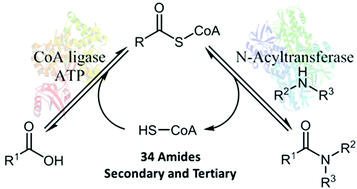当前位置:
X-MOL 学术
›
Green Chem.
›
论文详情
Our official English website, www.x-mol.net, welcomes your feedback! (Note: you will need to create a separate account there.)
A versatile biosynthetic approach to amide bond formation
Green Chemistry ( IF 9.8 ) Pub Date : 2018-06-28 , DOI: 10.1039/c8gc01697f Helena K. Philpott 1, 2, 3, 4, 5 , Pamela J. Thomas 2, 3, 4, 6, 7 , David Tew 1, 2, 3, 4, 5 , Doug E. Fuerst 1, 2, 8, 9 , Sarah L. Lovelock 1, 2, 3, 4, 5
Green Chemistry ( IF 9.8 ) Pub Date : 2018-06-28 , DOI: 10.1039/c8gc01697f Helena K. Philpott 1, 2, 3, 4, 5 , Pamela J. Thomas 2, 3, 4, 6, 7 , David Tew 1, 2, 3, 4, 5 , Doug E. Fuerst 1, 2, 8, 9 , Sarah L. Lovelock 1, 2, 3, 4, 5
Affiliation

|
The development of versatile and sustainable catalytic strategies for amide bond formation is a major objective for the pharmaceutical sector and the wider chemical industry. Herein, we report a biocatalytic approach to amide synthesis which exploits the diversity of Nature's amide bond forming enzymes, N-acyltransferases (NATs) and CoA ligases (CLs). By selecting combinations of NATs and CLs with desired substrate profiles, non-natural biocatalytic pathways can be built in a predictable fashion to allow access to structurally diverse secondary and tertiary amides in high yield using stoichiometric ratios of carboxylic acid and amine coupling partners. Transformations can be performed in vitro using isolated enzymes, or in vivo where reactions rely solely on cofactors generated by the cell. The utility of these whole cell systems is showcased through the preparative scale synthesis of a key intermediate of Losmapimod (GW856553X), a selective p38-mitogen activated protein kinase inhibitor.
中文翻译:

通用的生物合成方法来形成酰胺键
通用和可持续的酰胺键形成催化策略的开发是制药行业和更广泛的化学工业的主要目标。在这里,我们报告了一种酰胺合成的生物催化方法,该方法利用了自然界中形成酰胺键的酶,N-酰基转移酶(NAT)和CoA连接酶(CL)的多样性。通过选择具有所需底物特征的NAT和CL的组合,可以以可预测的方式构建非天然的生物催化途径,以允许使用化学计量比的羧酸和胺偶联伙伴以高收率获得结构多样的仲和叔酰胺。可以使用分离的酶在体外或体内进行转化反应仅依赖于细胞产生的辅因子。这些全细胞系统的实用性通过Losmapimod的关键中间体(GW856553X)的制备规模合成得到展示,Losmapimod是一种选择性的p38促分裂原活化蛋白激酶抑制剂。
更新日期:2018-07-30
中文翻译:

通用的生物合成方法来形成酰胺键
通用和可持续的酰胺键形成催化策略的开发是制药行业和更广泛的化学工业的主要目标。在这里,我们报告了一种酰胺合成的生物催化方法,该方法利用了自然界中形成酰胺键的酶,N-酰基转移酶(NAT)和CoA连接酶(CL)的多样性。通过选择具有所需底物特征的NAT和CL的组合,可以以可预测的方式构建非天然的生物催化途径,以允许使用化学计量比的羧酸和胺偶联伙伴以高收率获得结构多样的仲和叔酰胺。可以使用分离的酶在体外或体内进行转化反应仅依赖于细胞产生的辅因子。这些全细胞系统的实用性通过Losmapimod的关键中间体(GW856553X)的制备规模合成得到展示,Losmapimod是一种选择性的p38促分裂原活化蛋白激酶抑制剂。



























 京公网安备 11010802027423号
京公网安备 11010802027423号